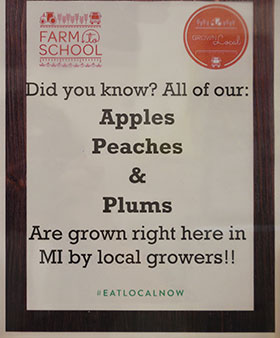Katie Hofman didn’t miss a beat when she was asked whether she planned to try some spaghetti squash at lunch.
“I like to try new things,” said the Murray Lake Elementary fifth-grader as she alternated bites of pancake dipped in syrup and steamed broccoli.
At the other end of the cafeteria, enjoying what he declared was a “very balanced” lunch of a pizza bagel, red grapes and strawberry-flavored milk, Ezequial Gonzalez didn’t think he was up to the challenge — at first.

“I don’t like squash,” he said firmly.
Minutes later, he had gotten in line to try some. “My taste buds have changed, so I think I will try it,” he said. “When I was 7, I liked tomatoes but when I was 8, I didn’t anymore.”
Added buddy Logan Bledsoe: “I’ll try it after he tries it.”
That’s what district Food Service Director Mindy Grant likes to hear, because trying new foods is on her to-do list for students.
Lowell Area Schools received a grant from the Michigan Department of Education for up to an additional 10 cents per meal this school year to purchase Michigan produce.
Lowell and Thornapple Kellogg Public Schools were the only two districts in Kent ISD’s service area to receive the “10 Cents a Meal for School Kids & Farms” grant.
Forest Hills Public Schools was the sole Kent ISD district that was part of last year’s pilot. This year’s grant awards in the program are spread throughout three regions and 29 counties of northwest, west and southeast Michigan.

Good for Kids and Business
Legislators expanded the program from $250,000 in state seed funding to $375,000 for this school year, and added a third region to last year’s two.
This year’s 32 grant-receiving districts (out of 78 that applied) serve an estimated 95,000 students, compared with 48,000 students served last year by 16 grant recipients. Food service directors last year named 30 new foods they tried in meals.
State Sen. Goeff Hansen, R-Hart, who chairs the Appropriations Committee’s K-12, School Aid, Education Subcommittee, said in a press release that the Legislature decided to expand the program after seeing how the pilot exposed children to locally-grown produce options in school.
It is also creating partnerships between school districts and their local agricultural producers. In its first year, the farm-to-school program provided more than $114,000 in sales to 86 farms in 28 counties and 16 additional businesses, such as processors and distributors, according to MDE.
Produce that comes from Michigan farms is distributed to schools by Cherry Capital Foods in Traverse City.
Three other states — Oregon, New Mexico, and New York, as well as Washington, D.C. — have launched similar programs that provide funding for schools to purchase locally grown food.

Chunky, but Good
Back at the Murray Lake squash tasting, Grant was deluged by fifth-graders at the first lunch period, who had been encouraged by Principal Molly Burnett during morning announcements to try the orange-yellow vegetable grown at Victory Farms in Hudsonville.
“I liked it,” said Katie, though her friend Ariana Fredricks called it “chunky.”
Ezequial pronounced it tasty, and classmate Patrick Hoke announced, “I actually, for the first time, want seconds of squash.”
Grant said the “10 cents” grant expands what the district has been doing for years already regarding fresh food and new choices.
At the high school, where the cafeteria has recently undergone upgrades for the approximately 400 meals served each day, fresh-made smoothies that share a shelf with hummus and with yogurt parfaits will soon be blended using Michigan peaches and strawberries. The cafeteria’s fresh produce station also includes Michigan blueberries, apples, peaches and plums.
“Last month we did smoothies with local carrots” and frozen pineapple, Grant said. “They went over amazingly fantastic, actually.”
And while breaded chicken — baked, not fried — remains a favorite in district cafeterias, more and more students are reaching for caesar salad wraps, mango smoothies and fresh-baked bread for their sub sandwiches — which isn’t required to be whole-grain, but is in Lowell.
“I think a lot of people think of food service a certain way, and are surprised when they learn what we actually serve,” said Grant, a dietitian. “It’s a really delicate balance between offering what is good for students and what they will actually eat. But our numbers are going up every year.”
CONNECT
10 Cents a Meal for School Kids & Farms
Cherry Capital Foods and Schools











